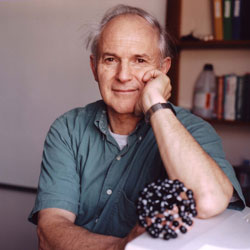Sir Harold Kroto
 |
Francis Eppes Professor Department of Chemistry and Biochemistry The Florida State University Tallahassee, FL 32306-4390 U.S.A. Phone:   http://www.kroto.info kroto@chem.fsu.edu |
|
Sir Harold (known as Harry) obtained a BSc in Chemistry (1961) and a PhD in Molecular Spectroscopy (1964) at the University of Sheffield. After a post-doctoral position at the National Research Council in Ottawa from 1964 to 1966 he spent a year at the Murray Hill Bell Laboratories in New Jersey and in 1967 he started his academic career at the University of Sussex in Brighton, U.K. By 1970 he had carried out research in the electronic spectroscopy of gas phase free radicals and was moving on to liquid phase Raman studies. By 1974 he had finally obtained a much awaited microwave spectrometer and the first molecule he used it for was the carbon chain species HC5N. Laboratory and radioastronomy studies on long linear carbon chain molecules led to the surprising discovery that existed in interstellar space and also in stars. Laboratory experiments with co-workers at Rice University which simulated the chemical reactions in the atmosphere of red giant stars uncovered the existence of C60 in 1985. C60 is an elegant molecule shaped as a soccer ball and named Buckminsterfullerene to honour the American architect who had conceived the geodesic dome that the molecule, on a microsocopic scale, seems to replicate. The discovery of C60 caused Kroto to shelve his dream of setting up a studio specialising in scientific graphic design (which he had been doing semi-professionally for years). He therefore decided to probe the consequences of the C60 concept and to exploit the synthetic chemistry and material sciences application. In 1990 hewas elected a Fellow of The Royal Society and in 1991 he has awarded a Royal Society Research Professorship which enabled him to concentrate on research. From 1990 - 1998 he was chairman of the editorial board of the Chemical Society Reviews. In 1995, he inaugurated the Vega Science Trust (http://www.vega.org.uk) to create science films of sufficient high quality for network television broadcast. The following year he was knighted for his contributions to chemistry and awarded the Nobel Prize for Chemistry together with Robert Curl and Richard Smalley. From 2002-4 he was President of the Royal Society of Chemistry. In 2007 he he started a new educational initiative at Florida State University known as GEOSET - Global Eduaction Outreach in Science, Engineering and Technology - http://www.geoset.info He has received honorary degrees from a number of universities in the UK and abroad, as well as many scientific awards including the International Prize for New Materials by the American Physical Society (1992), the Italgas Prize for Innovation in Chemistry (1992), the Royal Society of Chemistry Longstaff Medal (1993), the Faraday Award (2001) and the Copley Medal of the Royal Society (2002). He was elected to the National Academy of Sciences in 2007. | |
